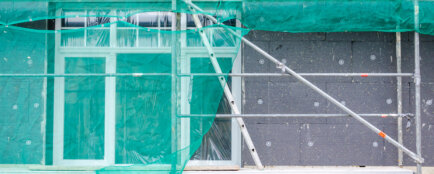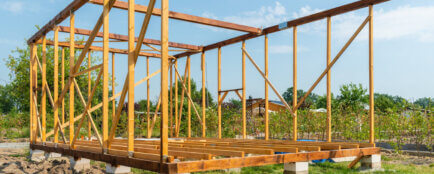The most important changes brought by the new Building Act are as follows:
Basic and accelerated proceedings
According to the amendment to the Construction Act, we have only one procedure. However, it is not based on the central concept of “building permit” as before, but works with the terms “planning permission” and “building permit”. At the same time, however, the law says that an intention means a building, a set of buildings or a facility. This implies that they are really one procedure. In the case of a building permit, in addition to the conditions for a planning permission, the other requirements for a building permit must be met.
An alternative to the basic procedure is the accelerated procedure, which can be used for simpler cases. This has replaced our existing planning consent and building notification. It is possible to issue a permit as the first step in the procedure.
The basic time limit for the length of the procedure is 60 days, within which the building authority will have to consider the application. For so-called simple constructions, the time limit is reduced to 30 days. It can then only be extended by 60 days. Now, in a single procedure, the construction is assessed both in terms of its location and its authorisation.
The new Building Act divides buildings into small (e.g. a building of up to 40 m2 with a maximum of one storey above ground or a greenhouse of up to 40 m2), simple (typically buildings for housing and family recreation, which have a maximum of two storeys above ground and one underground storey), reserved (buildings for motorways or railways) and other. The latter are not listed in the Act, so these are buildings that are not listed in Annexes 1, 2 and 3.
If the builder fails to submit binding opinions of the authorities concerned, the building authority will request them itself, without asking the builder to submit them or stopping the building procedure because of this.
Another new principle in the proceedings under the new Building Act is the mandatory decision of the appeal authority. In other words, if you appeal against the first-instance decision and even the appeal authority does not agree with it, it will have to make a final decision itself. The introduction of the principle of appeal will once again shorten the often protracted proceedings.
Are you solving a similar problem?
Are you unsure about the amendment to the Building Act?
We know all the new features introduced by the new Building Act. If you are not sure how to proceed with a building permit, for example, please contact us. We will advise you and guide you through the amendments to the Building Act in a clear way so that you understand what you need to do in a specific case concerning your building.
I want to advise
- When you order, you know what you will get and how much it will cost.
- We handle everything online or in person at one of our 6 offices.
- We handle 8 out of 10 requests within 2 working days.
- We have specialists for every field of law.
Building authorities
The new Construction Act introduced a new Transport and Energy Construction Authority (DESU), which decides on reserved structures (such as railways, aeronautical structures or nuclear structures).
The original version of the law introduced many more changes in this respect. There was even to be a new system of state construction authorities, including the Supreme Construction Authority. However, a number of construction experts criticise this step (i.e. the amendment of the originally intended law) in this respect, as a unified and common management of construction authorities could benefit the predictability of their decision-making. In reality, however, this would probably not work, as the new offices would not be able to find enough qualified people.
Tip for article
Tip: The official board is an important element of public administration in the Czech Republic. It is no longer a bulletin board in the lobby of an office, but typically a digital panel or online portal where citizens can find out a lot of useful information. What information is published on the notice board and how can it be useful to ordinary citizens? This is the subject of a separate article.
JES – Joint Environmental Statement
All projects permitted under the Building Act now require the issuance of a so-called Single Environmental Statement, abbreviated as JES, which is issued outside the building permit procedure itself and replaces up to 26 administrative acts contained in 9 different environmental laws (e.g.the Air Protection Act, the Nature and Landscape Protection Act or the Water Act). If the project requires an Environmental Impact Assessment(EIA) and the developer requests it, the JES will include a binding EIA opinion. In some specific cases, the competent authority issuing the EIA will be the regional authority.
The new Construction Act continues to allow for the possibility of issuing separate decisions or opinions in specific cases. Administrative acts issued by nature protection authorities in specially protected areas, sites of European significance and bird areas are thus not included in the EIA.
Validity of the building permit
The new Building Act stipulates that a permit is valid for 2 years from the date of entry into force, unless the building authority stipulates a longer period in justified cases, but no longer than 5 years. However, unlike the original law, the validity of the planning permission is further extended so that if the implementation of the project has started during its validity, the validity period is extended to 10 years from the date of the legal validity of the permission.
Tip for article
Tip: Do you have administrative proceedings coming up and would you like to prepare for them? Or are you a participant in the ongoing process and want to know the next steps of the administrative authority? In our article, we will introduce the course of the administrative proceedings, get to know the participants and also focus on how to proceed if the administrative authority does not fulfil its role.
New institution of joint negotiation
The joint meeting between the building authority and other authorities concerned (with the participation of the builder and other parties to the proceedings, if any) is a newly introduced institute that is intended to increase communication and eliminate the contradictions that buildings often cause.
Stricter conditions for additional permitting of “black” buildings
The new Construction Act is also known for tightening the conditions for the additional permitting of so-called “black buildings“, built without a permit or in violation of its conditions. Their additional legalisation will be possible, but only if the conditions foreseen by the law occur.
- the building does not require an exemption from the building requirements (the setbacks are met or the affected neighbours give their consent, the coefficient of land development is met, etc.),
- the fine for the offence has been paid,
- the building does not require a decision to grant an exemption from the prohibitions of another legal regulation.
In the above circumstances, the building authority shall authorise the building by a new decision.
How was the digitalisation of the construction procedure carried out?
The law introduced electronic submissions, but also left the possibility of submitting the application in paper form. If the documentation has to be prepared by a designer, it has to be submitted to the building authority in electronic form. For buildings where the documentation does not need to be prepared by a designer, it can be submitted to the building authority in paper form.
However, the digitisation itself consists primarily in the creation of the so-called Builder’s Portal. This is essentially similar to the Citizen’s Portal, but focused exclusively on construction proceedings. The portal is a basic interface for digital communication with the state in the field of construction proceedings, i.e. mainly with construction authorities and the authorities concerned and administrators of technical and transport infrastructure.
The aim of its creation was to facilitate communication between builders, building authorities and the authorities concerned. Builders can find information about the processes of construction proceedings, forms , etc. They can also follow the entire course of the proceedings, consult records and files, or fill in missing documents.
How is the transition to the new legislation dealt with legally?
Proceedings initiated under the previous legislation are also completed under the existing legislation. Until 30 June 2027, project documentation prepared under the previous legislation can be submitted with new applications for planning permission.
Summary
The new Construction Act, effective from 1 January 2024, has fundamentally changed the shape of the construction procedure in the Czech Republic. It has introduced a single procedure for permitting both the plan and the construction, an accelerated procedure for simpler constructions and redefined the categories of constructions. The process has been speeded up thanks to fixed deadlines, digitalisation and the fact that the authorities themselves request the necessary opinions. A Single Environmental Statement (SEA), a new institution of joint negotiation and stricter rules for the additional authorisation of black buildings have been introduced. Changes have also affected building authorities, with the creation of a specialised DESU. Building permits are now valid for up to 10 years if construction has started on time.
Frequently Asked Questions
When did the new Building Act come into force and who is affected?
The new Building Act came into force on 1 January 2024 and applies to all builders, whether they are individuals planning a family house or large investors carrying out large-scale construction. The law unified the existing planning and construction procedures into one process – the planning permission procedure. This should speed up and simplify the entire construction procedure.
What are the main innovations brought by the new Building Act?
The most important changes include the introduction of a single building permit procedure, the digitisation of the process through the Builder’s Portal and the creation of a new authority – the Transport and Energy Construction Authority (DESU). The new Construction Act as amended also introduced the Single Environmental Statement (SES), which unifies a number of existing environmental permitting processes.
How long are building permits valid under the new law?
The validity of the building permit is now set at 2 years from the date of the decision’s entry into force, while the building authority may extend this period up to 5 years. However, if the builder actually starts construction within this period, the validity of the permit is automatically extended up to 10 years. In this way, the new Construction Act tries to take into account the real time needed to implement construction projects.
How to proceed if the proceedings were initiated under the old law?
According to the transitional provisions, all proceedings initiated under the former legislation shall be completed under that legislation. In addition, project documentation prepared under the previous legislation may be submitted until 30 June 2027. This step is intended to ensure a smooth transition between the old and the new rules of construction law.




